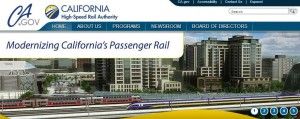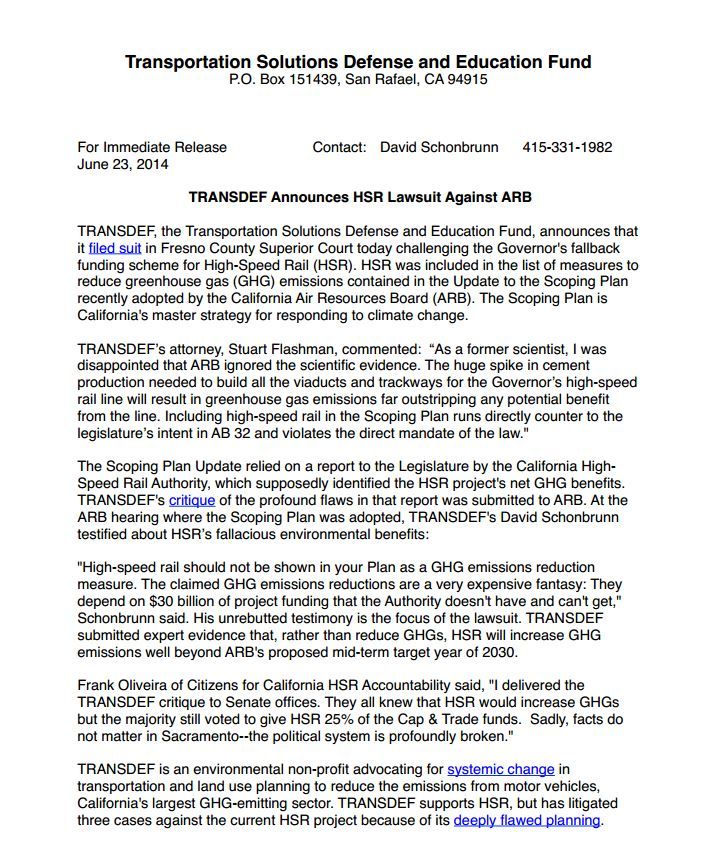New suit filed against high-speed rail
by Kathy Hamilton | June 24, 2014 2:04 pm

On June 23, the Transportation Solutions Defense and Education Fund filed a new lawsuit against California’s high-speed rail project. TRANSDEF supports the project, but not the current planning.
In a statement explaining the suit, TRANSDEF challenged “the Governor’s fallback funding scheme for high-speed rail.” In that system, Gov. Jerry Brown and the Legislature last week agreed to include $250 million in funding for the project to come from the cap-and-trade emissions trading system[1] set up two years ago by the California Air Resources Board under the auspices of Assembly Bill 32[2], the Global Warming Solutions Act of 2006.
The funding will be for fiscal year 2014-15, which begins on July 1. The governor originally asked for 33 percent of the cap-and-trade revenues. Then his request was reduced to 25 percent in the final version of Senate Bill 862[3], the cap-and-trade funding bill.
But as CalWatchdog.com earlier reported[4], the cap-and-trade mechanism is highly irregular and faces court challenges from the Pacific Legal Foundation and the Chamber Commerce.
Lawsuit
TRANSDEF charged that cap-and-trade revenues, according to AB32, only can go to reduce greenhouse-gas emissions. TRANSDEF President David Schonbrunn said in the statement, “The claimed GHG [greenhouse gas] emissions reductions are a very expensive fantasy,” because the California High-Speed Rail Authority depends “on $30 billion of project funding that the Authority doesn’t have and can’t get.” (See a copy of the full statement at the end of this article.)
TRANSDEF attorney Stuart Flashman said, “It is highly ironic what the Air Resources Board has done. It was entrusted with making use of these funds [from cap-and-trade] to reduce CO2 [carbon dioxide] production. Instead, it approved using the funds to help construct the first segment of high-speed rail tracks. This not only won’t operate as high-speed rail, it will actually result in an undisclosed increase in greenhouse gas production.”
Defending the cap-and-trade funding
CHSRA CEO Jeff Morales defended using the cap-and-trade funds in a letter to state Sen. Fran Pavley, D-Los Angeles, before the Legislature voted on the funding:
“The ongoing commitment of cap and trade proceeds creates significant new opportunities for rail and transit improvements, including high-speed rail. Most significantly, it will allow the Authority to advance the program on multiple segments concurrently. This has a number of key benefits, which will result in GHG reductions sooner, including: overall acceleration of the program, which can also yield cost savings; and improvements in Southern California’s existing rail system, which will benefit commuters in the region in the near-term and ultimately tie into the broader system.”
He said the cap-and-trade funding also would allow the CHSRA to:
“… continue the development and construction of the spine of the system in the Central Valley, utilizing previously appropriated federal and state funds. We would also continue the work with our partners in the Bay Area to electrify the Caltrain corridor, targeted for completion in 2019. Cooperative efforts with the Capitol Corridor and Altamont Commuter Express rail services would continue, aimed at creating a cohesive passenger rail network in Central and Northern California.”
In summary, defenders of using the cap-and-trade funding believe that, because the project will be funded yearly at a 25 percent or more share of the future cap-and-trade revenues, it will provide a continuous stream of dedicated income. That money will show the federal government that California is serious about building the rail project.
SB862 Senate hearing and vote
At the Senate hearings on the budget that was passed, Pavley expressed concern about giving 25 percent of the cap-and-trade revenues to the current high-speed rail project because it produced only 1 percent of the needed greenhouse gas reduction reductions under AB32. The state is required to bring greenhouse gas readings down to 1990 emissions levels by 2020. Pavley authored AB32.
She said she hoped that, if the bill passed, the CHSRA and the Senate would concentrate on the “bookend” train stations, meaning Los Angeles and San Francisco, where there is more population and greater greenhouse gas reduction would be possible. Pavley ended her comment, then sat down without calling for a vote for or against SB862. She later abstained from voting.
New Senate President Pro Tem Kevin de Leon, D-Los Angeles, mentioned that Morales had circulated letters to some of the senators. The letter sent to Pavley suggested that, if SB862 passed, the cap-and-trade money could allow work beyond the first section in the Central Valley, possibly the Burbank-to-Palmdale section.
But that would be difficult with not enough money to complete the first section. Burbank-to-Palmdale is about 51 miles and would cost at least $6.73 billion.
Hookup with Xpress West in Nevada
Morales continued:
“The Burbank-Palmdale segment, which potentially could become an operating segment on its own, would accelerate benefits to the Los Angeles region. It would also allow for the earlier connection of our system with the proposed XpressWest.[5]
“As you can imagine, a high-speed, electric rail connection from Los Angeles to Las Vegas would provide tremendous benefits for the region, both in terms of travel and GHG [greenhouse gas] reductions.”
But the train project to Las Vegas itself has run out of steam. See the letter[6] written to the Comptroller General of the United States by U.S. Sen. Jeff Sessions, R-Ala., and Rep. Paul Ryan, R-Wisc., who wrote:
“We have been informed that the letter [from the Department of Transportation] explains that ‘serious issues persist’ with the XpressWest loan application; that there are ‘significant uncertainties still surrounding the project’; and that, as a result, [the DOT] has ‘decided to suspend further consideration’ of the XpressWest loan request.”
Rolling dead?
Assembly Member Jeff Gorell, R-Camarillo, said at the hearing that high-speed rail is “mortally wounded.” Although some would argue it’s more like the walking dead — or perhaps rolling dead — since it doesn’t have the time or the money to complete even the first Initial Operating Segment.
Yet it appears the project is nearly bullet-proof and very much among the living. Brown remains strongly behind the project and has the backing of President Obama. A June 9 Statement of Administration Policy[7] from the Office of Management and Budget declared:
“The Administration strongly objects to prohibiting the Surface Transportation Board from taking any action to approve subsequent phases of the California High Speed Rail project between Los Angeles and San Francisco. The Administration believes passenger rail can play an important role in addressing transportation needs and opposes any attempts to limit state and local choices to enhance passenger rail.”
Kathy Hamilton is the Ralph Nader of high-speed rail, continually uncovering hidden aspects of the project and revealing them to the public. She started writing in order to tell local communities how the project affects them and her reach grew statewide. She has written more than 225 articles on high-speed rail and attended hundreds of state and local meetings. She is a board member of the Community Coalition on High-Speed Rail; has testified at government hearings; has provided public testimony and court declarations on public records act requests; has given public testimony; and has provided transcripts for the validation of court cases.

- cap-and-trade emissions trading system: http://www.arb.ca.gov/cc/capandtrade/capandtrade.htm
- Assembly Bill 32: http://www.arb.ca.gov/cc/ab32/ab32.htm
- Senate Bill 862: http://leginfo.legislature.ca.gov/faces/billNavClient.xhtml?bill_id=201320140SB862
- earlier reported: http://calwatchdog.com/2014/04/24/experts-question-legality-of-cap-and-trade-for-high-speed-rail/
- XpressWest.: http://www.xpresswest.com/
- letter: http://reason.com/assets/db/13736556125840.pdf
- A June 9 Statement of Administration Policy: http://www.whitehouse.gov/sites/default/files/omb/legislative/sap/113/saphr4745h_20140609.pdf
Source URL: https://calwatchdog.com/2014/06/24/new-suit-filed-against-high-speed-rail/